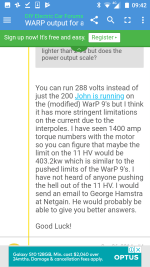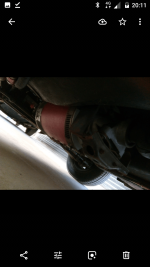Thanks mate.
Note sure of actual torque figures. Theoretically it is around 160ft/lbs but that is on paper based on 600amps. I am pushing 1000amps through mine (for short periods).
The 0-100 is about 4.5 seconds.
The battery pack is about 60kg, 1m long 0.4 m wide and 0.5 high. Cost is difficult but as per any battery figure on about $1000 per Kwh for new or about $300 per Kwh second hand. The figure of 7c springs to mind but it has been a few years since I was doing the research. But keep in mind you can run more cells in parrallel to increase the C rating (so long as they are the same cells and the consistant number in series).
Motor choice is quite difficult. There are so many choices and variables. Price, Power, weight, regen, AC/DC, availability, compatibility with controllers, voltage, current are the factors you need to consider. Warp9 is a solid choice but I am not sure it would stack up against your original goals. I would be glad to hear if you have diluted those requirements though. I think they were a tad optimistic on that budget and probably overkill for the result you are seeking. To put it another way the figures you were quoting don't seem to align with the results you describe in your last post. If you want great acceleration like mine and just achieve slightly more than 100kmph then you only need 90kw and 1000amps like mine. I'm not saying you shouldn't aim higher but in EVs the cost curve is exponential. The more power and the more weight you deal with the more it will cost you. Also keep in mind when I say 90Kw that is a peak power figure. Most motors are specified as continuous which is roughly a 3rd.
I hope this helps. I am happy to answer more questions if you have any.
Note sure of actual torque figures. Theoretically it is around 160ft/lbs but that is on paper based on 600amps. I am pushing 1000amps through mine (for short periods).
The 0-100 is about 4.5 seconds.
The battery pack is about 60kg, 1m long 0.4 m wide and 0.5 high. Cost is difficult but as per any battery figure on about $1000 per Kwh for new or about $300 per Kwh second hand. The figure of 7c springs to mind but it has been a few years since I was doing the research. But keep in mind you can run more cells in parrallel to increase the C rating (so long as they are the same cells and the consistant number in series).
Motor choice is quite difficult. There are so many choices and variables. Price, Power, weight, regen, AC/DC, availability, compatibility with controllers, voltage, current are the factors you need to consider. Warp9 is a solid choice but I am not sure it would stack up against your original goals. I would be glad to hear if you have diluted those requirements though. I think they were a tad optimistic on that budget and probably overkill for the result you are seeking. To put it another way the figures you were quoting don't seem to align with the results you describe in your last post. If you want great acceleration like mine and just achieve slightly more than 100kmph then you only need 90kw and 1000amps like mine. I'm not saying you shouldn't aim higher but in EVs the cost curve is exponential. The more power and the more weight you deal with the more it will cost you. Also keep in mind when I say 90Kw that is a peak power figure. Most motors are specified as continuous which is roughly a 3rd.
I hope this helps. I am happy to answer more questions if you have any.




